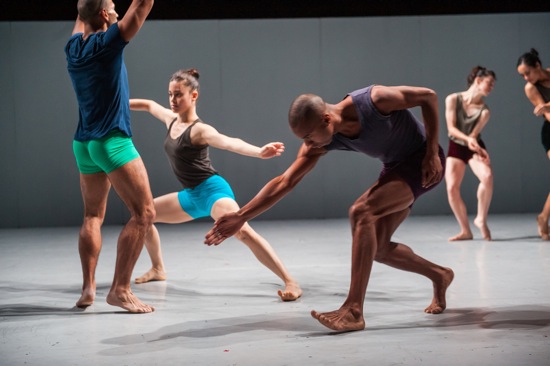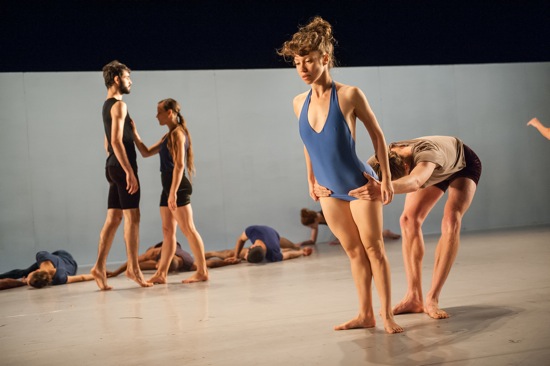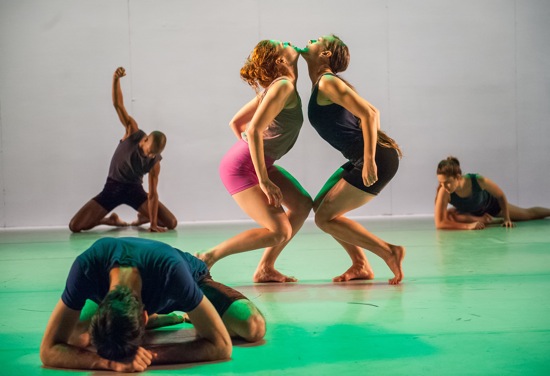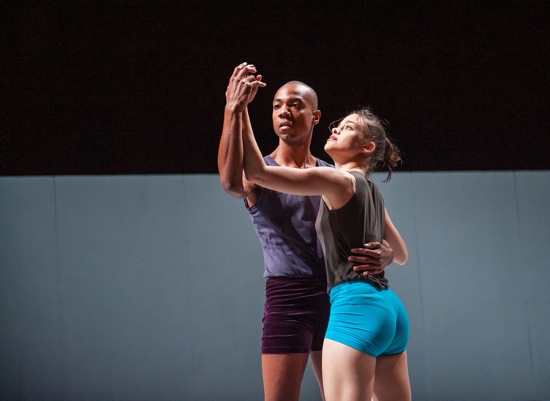Batsheva Dance Company celebrates its 50th anniversary.

(Foreground, L to R): Batsheva’s Oscar Ramos, Iyar Alezra, and Shamel Pitts in Ohad Naharin’s Sadeh21. Photo: Stephanie Berger
Fifty years ago in Israel, Baroness Bethsabée (aka Batsheva) de Rothschild (1914-1999) founded the Batsheva Dance Company. Enamored of dance, she had, during her years in New York, studied with Martha Graham and become a patron of her work. Choreography by Graham was initially a part of Batsheva’s repertory and the training of its dancers. Fast forward over changes in the company’s directorship and mission to 1990; that’s when Ohad Naharin—who trained both with Batsheva and in New York at Juilliard during the 1970s and formed his own small New York group in the 1980s—took over the company and became its principal choreographer.
Given that 2014 is the 50th anniversary of the company’s founding, it seems appropriate that Naharin chose to present Sadeh21, a piece that premiered in 2011, for its season at the Brooklyn Academy of Music. Why appropriate? Because even more than others of his works that I have seen, Sadeh21 celebrates the prowess, the beauty, and the humanity of the Batsheva dancers. It’s as if Naharin were saying in his choreography, “This is what this company is most fundamentally about: human spirit, humor, integrity, and valor.”
And individuality. Sadeh21 begins by startling the chatting audience with a tremendous crash and a thud. After we’re cowed into silence, a woman (Iyar Alezra) enters the white-walled space created by Avi Yona Bueno (Bambi). Now we can take in the astonishingly nuanced movements that are rooted in Gaga, now widespread technique that Naharin designed to render dancers more sensitive to the changes—both minute and cataclysmic—that happen every moment within the labyrinth of muscles, joints, and nerves that make up the human body and its multiple intelligences.
Watching Alezra and the nine (I think) other dancers who, one by one, succeed her onstage, I’m aware of their preternaturally flexible spines, their articulation of the differences between small, tight jerks and large smooth moves, and their bold, sensual muscularity. They can jump high, but often they’re low to the ground—whipping themselves into such big, straddle-legged steps that their centers of gravity have to descend. Nothing about them is loose. Every twist, every swing, every cantilevered balance has its carefully (often fiercely) calibrated force and destination. Rarely does any dancer seem unready, even if readiness includes being prepared to take a fall.
Sadeh21 is made up of 21 sections of varying lengths—all of them having arisen out of collaborative work between Naharin and the 18 dancers. Although Bambi’s lighting alters the stage atmosphere from time to time (cooling it to afternoon bluish, warming it midday sun), and the musical selections that form part of Maxim Waratt’s score (“Waratt” is a Naharin alter ego) vary from David Darling and Brian Eno to Autechre and Jun Miyake, there are few dead, begin-again stops in Sadeh21.

Ohad Naharin’s Sadeh21. (L to R): Omni Drumlevich, Bobbi Smith, Adi Zlatkin, and Ian Robinson. Photo: Stephanie Berger
The speed and overlap of the initial solo appearances quicken, and alliances form and dissolve. Occasionally those people onstage—or some of them—freeze, creating a landscape with figures. (“Sadeh” may be translated as “field,” and can be taken both as a fertile place and as a domain of activity.) Shortly after “Sadeh 2” is projected on the back wall, Ian Robinson enters with Adi Zlatin slung over his shoulder and puts her down front and center. While these two wrangle and explore each other in a conscribed space to a sweetish melodic passage of music, other things are happening behind and around them. Occasionally William Barry waves one arm in an unemphatic way; occasionally Brett Easterling, hunkered down, explodes into a bent-kneed jump, lands, and freezes again. Three women, their backs to the audience, link arms overhead and, swaying their hips from side to side, move slowly upstage. There’s more going on in this vignette than I’ve described.
At one point Zlatin slaps Robinson When he falls and others scrabble over him, she begins a curious solitary passage around the perimeter of the stage. She’s marching with small steps and at the same time, thrusting one hip out, creating a hobbled gait. Eventually she stops at the front of the stage and, staring in our direction, says combinations of numbers, such as “5!” Then, after a pause, “2,1,1,1.” Four other dancers start rushing around, grouping and separating, as if in response to her words. I get the idea that she could be ordering them to, say, form a pair, or go it alone, or become a seconds-long trio. As the pace of her commands pick up speed, so do their dashings-about. Alone and together, they work fiercely, crazy with trying to do whatever it is they’re supposed to be doing.
Some of the images appear only briefly—as tender as one person leaning over a fallen comrade or as violent as a small group of packed-together people exploding into pushes, pulls, lifts, and drops. Unexplained jokes crop up. Nitzan Ressler stands facing us as if she has something to convey; then her pants fall down, displaying her red-and-white striped briefs. She doesn’t react, just pulls them up as she moves into her next pattern. Omri Drumlevich plants himself at the center front of the stage. Seconds pass. Then he opens his mouth and starts talking gibberish to us in a high falsetto. He’s endearing and infuriating—both uncertain and unstoppable. Rachael Osborne starts advancing on him by inching along on her coccyx, her legs and arms in the air—a living letter V (!). Once beside him, she clamps her legs around one of his and clambers up him. Eventually she forces him—still telling his story—to move along and shut up.
In their own way, such incidents—like the passages of out-and-out marvelous dancing—are expressive but enigmatic. Yet neither induces us, the viewers, to feel a need to interpret them. We can watch Zina Zinchenko and Bobbi Smith, equally matched in a head-to-head dispute that include touching profiles and rubbing along their contours, and not query a possible relationship between them and the surrounding company members who behave as if they’re pounding nails into the floor in slow motion.
Why do the men suddenly accumulate onstage wearing mid-length, bouffant black tutus , leaping and turning in off-kilter ways, while the women, planted in front of them whirl one arm with ferocious strength and concentration, and Smith (now in hot pink) performs smooth acrobatic feats and uncanny stretches. Let’s not take the time for deep musings about gender, or ballet, or circuses. Whiffs of thought are enough.
Or how’s this for a resonant image? All eight men stand facing us with their arms across one another’s shoulders. Slowly and in unison, each lifts a bent leg, pauses, sets it down, and lifts the other. Sometimes they separated and move back or forward, gesturing, but always they return to their line. They’re quite silent and often still, but a constant harder pace is provided by Maayan Sheinfeld. She, lying on her back to one side of them, “marches” her heels noisily on the floor, without traveling from her spot on the floor. Do you think about snapshots of a folk dance? Of an army? Neither?
For all their virtuosity and their gazes at the audience, Batsheva’s dancers don’t “perform” for us. They’re bent on their tasks and on one another, sometimes introspective—sensing the air on their skins, and deeper matters. I like the moment when, one by one, they leave off what they’re doing and just walk in a circle that gets larger and larger. All the superb dancers—including Mario Bermudez Gil, Rani Lebzelter, Oscar Ramos, Nitzab Ressler, Or Meir Schraiber, and Eri Nakamura (she of the long miraculous balances on one leg)—walk quietly, holding hands, as if a folk dance could begin any moment. But it doesn’t.
Naharin doesn’t disallow the value of theatrical effects. Finally, after a slew of shorter selections (the projected “Sadeh 7-18” gets a laugh from the audience), the stage empties, and a single dancer appears on the top of the rear “wall,” stares at us for a second or two, and then falls backward into oblivion. The piece ends with all the performers clambering onto the wall and falling out of sight as if shot, or flying into swan dives and other bold shapes on the way down. Over and over, in rapid succession, they climb and take off, exulting in challenging gravity, counting on a soft landing. This is what they do—in their dreams, in their lives—every day.


